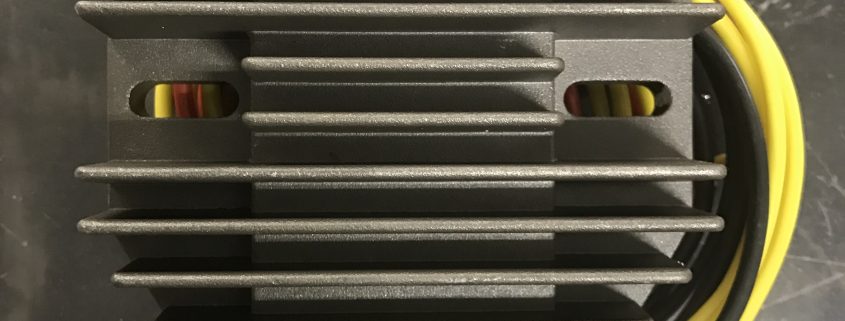MOSFET Regulators? Why?
It’s been a while since we’ve updated the Blog, but here ya go!
Let’s talk Charging Systems and Regulators…
This may come as a surprise to lots of you, and even myself included, but Regulators are considered a wear item, much like Tires or Brakes, they have a lifespan.
That lifespan is based on how it is used, much the same as your brakes and tires.
Lost yet?
Here’s how it works. Let’s consider our 200W PMA System, which has been wildly popular… Thats 200W Max, at roughly 5500 RPM or so. When we first launched that product, 200W was a perfect fit for these vintage bikes. Considering a 55w/65w Headlight, a 9w Running Light, and a 27W brake light, add in a few lights for your guages and ignition (Points ignition is roughly 20W at idle) – you get a bit of a load on the system.
Lets go for a nice average ride:
Lets say High Beams, and sitting a red light, waiting to turn left, with the brake light on.
65W Headlight
9w Running Light (Rear)
21w Brake Light
21W Turn Signal
9w Running Light (front)
10-20W Guage Lights
20W Ignition
Thats ~155-165W Total. Not too bad for a 200W (max) System such as our PMA, you always want a little extra power to charge the battery and to handle parasitic loss of course…
This would be a decently balanced system, not working the regulator too hard to dissipate excess wattage being created by the stator, and we saw very few issues with this setup, with either a battery or a capacitor (typically, the less accessories, the better the use of a capacitor of course)
OK, So whats the problem? Why has my regulator burned up?!?!?!
We’ve seen it mentioned time and time again, that LESS draw is easier on your electrical system. While less load on the wiring and connections is a good thing, it still leaves your charging system at risk.
Now, lets look at how some of the new builds we are seeing run. We are seeing a LARGE change to lower draw accessories.
Consider that modern LED Headlights are 3w/5w, and some of the new tail lights are as low as 1-2W. Lots of aftermarket ignitions are such low draw, we’ll say roughly 5W.
So you’ve built a sweet minimalist build, using all new tech LED’s for lighting and with a modern ignition system.
Lets go for a nice average ride on our cool build with modern lights and accessories:
Lets say High Beams, and sitting a red light, waiting to turn left, with the brake light on.
3W High Beam
1W Running Light (rear)
2W Brake Light
2W Turn Signal
1W Running Light (Front)
2W Guage Lights
5W Ignition
Thats about 16W, not too shabby! You have very low draw, your wiring will thank you, you’ll have less heat in connections, and things are killer right? Wait, that 200W system is still kicking out 200W (max) – meaning the regulator is now having to “burn” off all of the excess energy being generated. Standard diode type regulators can and do overheat, and when they do, generally they fail internally. Remember the tire and brake analogy? Your system is too far our of balance.
Well, your regulator is basically doing a smoky burnout constantly to dissipate the energy being created by the stator. Bad news for the life of your regulator…
Whats the solution? We’ve teamed up with the engineers at RMstator to solve the problems we’ve been seeing on lots of systems (not just on our bikes, but other manufactures, as well as stock systems on vintage bike – remember, they we were all designed for higher draw components) – and we’ve decided that even though they are costly, we’ve seen NO Failures to date (someone will undoubtedly prove that wrong, knock on wood!) with MOSFET Regulators in these applications.
Whats the deal with MOSFET?
It runs cooler than all OEM diode style regulators. In addition, these rectifiers have overheat/overload protection, rather than burn up it will simply turn off for a while and cool off. Kind of like damage protection for your rides’ electrical system! With a rating of up to 350W, these bad boys might just be a bit overkill, but in this application, overkill is a good thing.
We dig it! We’ve been using and testing these for over a year now, with no issues to date, even just running ignition only (no lights) up and down I-40 on our 1975 Test Mule XS650. Basically a MOSFET Regulator finds the perfect balance for you, be it on a low draw system, or a high draw, it can handle it.
So we are now offering MOSFET Regulators as an option to our PMA Systems for XS650’s, and they are also a standard item on our NEW CDI Ignition/Charging Systems… You can also purchase a MOSFET 3 Phase Regulator in our store (I won’t be a salesman here, you can find it here on our site easy enough)
Great news for you, and now you can better assess the system your motorcycle needs.
Long live the XS650 (and other vintage bikes, but mostly XS650’s!)
Hugh




I built my bike 3 years ago and have put 3 regulators on since then, they seam to last about 75% of the summer then leave me sitting on the side of the road I hope this will be the last regulator I have to buy. I’m only running a headlight, tail/brake light, and pamco with a capacitor.
Thanks for this usefull information. I didn’t realize it. I keep it in mind in my next project.
Cheers, and ride safe ! Jeff
Great explanation of the charging system. I have a vintage 1984 Honda Goldwing in which I think this MOSFET system will help my ever failing stator.
Great story!
Been running a solid state Regulator/Rectifier since I built the bike, no problems until I blew a AGM battery, because of a broken wire – AGM batteries will give all their charge until completely dead 0V ! Fixed with little colourful chromed piece of relief – coloured readout voltage meter ! Bought from MikesXS, allows you to travel easy knowing that your system is working OK – and if not, you have the option to call the shots – not a roadside stop.
We found a really nice clean voltage meter can be helpful for sure. Something like this from RMStator works a charm.
Voltage Meter
Hugh,
What shoud I be seeing off my Mofset regulator? I have one of those LED voltmeters wired up and when I start the bike I’m seeing something like14.5 volts? I’m also running a LiPo battery.
Thanks
Ian Cooper
Ian – 14.9 is the highest you should see, and not for too long. 14.7 or lower is fairly typical of a good MOSFET Regulator